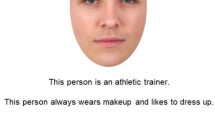Abstract
Women and men (58 females and 42 males) reported whether they possess each of several stereotypic and neutral traits (self-report criterion) and recorded the percentage of each gender they believed display each trait (diagnostic). Observations of subjects (57 males and 49 females) discussing controversial topics yielded the behavioral criterion. (Approximately 81% of the total sample was European-American, 8% African-American, 2% Hispanic, 1% Asian, and the remainder of “other” ethnicity.) Gender differences were larger and more inaccurate in stereotypes (diagnostic) than in “reality” (self-report criterion), but behavioral criterion results were mixed. Difficulties in specifying criteria for “actual differences,” including behavioral criteria, and recent work related to C. L. Martin's [(1987) “A Ratio Measure of Gender Stereotyping,” Journal of Personality and Social Psychology, Vol. 52, pp. 489–499] paradigm (and results) are considered. Implications of results for the importance of replication and for research on accuracy of stereotypes are also discussed.
Similar content being viewed by others
References
Allen, B. P. (1994).Theories of personality. Boston: Allyn and Bacon.
Allen, B. P., & Potkay, C. R. (1983).Adjective Generation Technique (AGT): Research and applications. New York: Irvington Publishers.
Baron, R. A., & Byrne, D. (1994).Social psychology (7th ed.). Boston: Allyn & Bacon.
Bem, S. L. (1981).The Bem Sex-Role Inventory: A professional manual. Palo Alto, CA: Consulting Psychologists Press.
Biernat, M., & Manis, M. (1994). Shifting standards and stereotype-based judgments.Journal of Personality and Social Psychology, 66, 5–20.
Bodenhausen, G. V. (1988). Stereotypic biases in social decision making and memory: Testing process models of stereotype use.Journal of Personality and Social Psychology, 55, 726–737.
Brigham, J. C. (1971). Ethnic stereotypes.Psychological Bulletin, 76, 15–38.
Brigham, J. C. (1986).Social psychology. Boston: Little Brown.
Eagly, A. H. (1987).Sex differences in social behavior: A social-role interpretation. Hillsdale, NJ: Erlbaum.
Eagly, A. H., & Carli, L. (1981). Sex of researchers and sex-typed communications as determinants of sex differences in influence ability: A meta-analysis of social influence studies.Psychological Bulletin, 90, 1–20.
Eagly, A. H., Makhijani, M. G., & Klonsky, B. G. (1992). Gender and the evaluation of leaders: A meta-analysis.Psychological Bulletin, 111, 3–22.
Eagly, A. H., & Steffan, V. J. (1984). Gender stereotypes stem from the distribution of women and men into social roles.Journal of Personality and Social Psychology, 46, 735–754.
Falkenberg, L. (1990). Improving the accuracy of stereotypes within the workplace.Journal of Management, 16, 107–118.
Hoffman, C., & Hurst, N. (1990). Gender stereotypes: Perception or rationalization?Journal of Personality and Social Psychology, 58, 197–208.
Judd, C. M., & Park, B. (1993). Definition and assessment of accuracy in social stereotypes.Psychological Review, 10, 109–128.
Jussim, L. (1991). Social perception and social reality: A reflection-construction model.Psychological Review, 98, 54–73.
Martin, C. L. (1987). A ratio measure of gender stereotyping.Journal of Personality and Social Psychology, 52, 489–499.
McCauley, C., & Stitt, C. L. (1978). An individual and quantitative measure of stereotypes.Journal of Personality and Social Psychology, 36, 929–940.
Mischel, W. (1973). Toward a cognitive social learning reconceptualization of personality.Psychological Review, 80, 252–283.
Rosenthal, R. (1979). The “file drawer problem” and tolerance for null results.Psychological Bulletin, 86, 638–641.
Spence, J. T., Helmreich, R. L., & Holahan, C. K. (1979). Negative and positive components of psychological masculinity and femininity and their relationships to self-reports of neurotic and acting out behaviors.Journal of Personality and Social Psychology, 37, 1673–1682.
Swim, J. K. (1994). Perceived versus meta-analytic effects sizes: An assessment of the accuracy of gender stereotypes.Journal of Personality and Social Psychology, 66, 21–36.
Author information
Authors and Affiliations
Additional information
Thanks are due Nancy Hobby and Brett Hart for conducting part of the study. Special thanks are also due Carol Martin for providing numerous thoughtful and helpful suggestions.
Rights and permissions
About this article
Cite this article
Allen, B.P. Gender stereotypes are not accurate: A replication of Martin (1987) using diagnostic vs. self-report and behavioral criteria. Sex Roles 32, 583–600 (1995). https://doi.org/10.1007/BF01544213
Issue Date:
DOI: https://doi.org/10.1007/BF01544213




